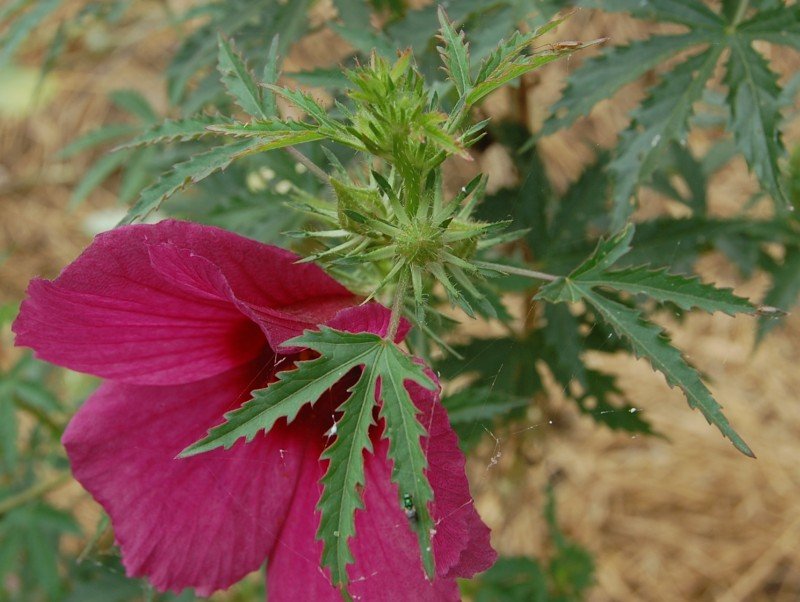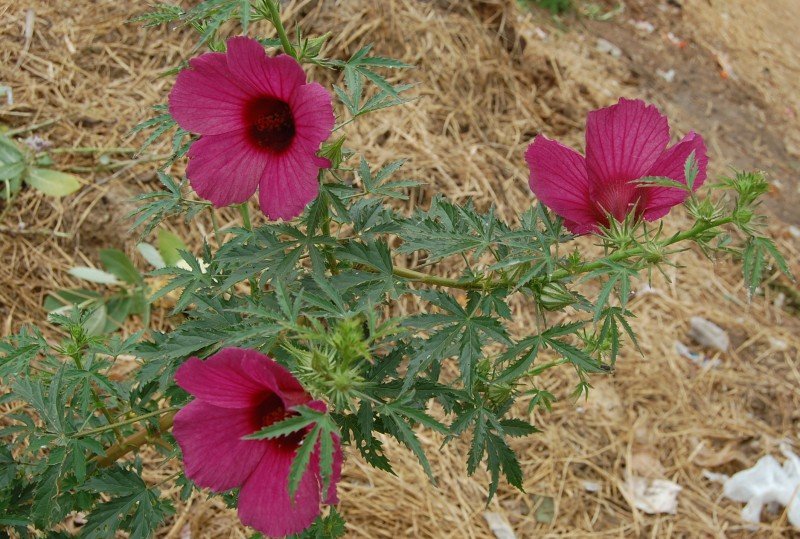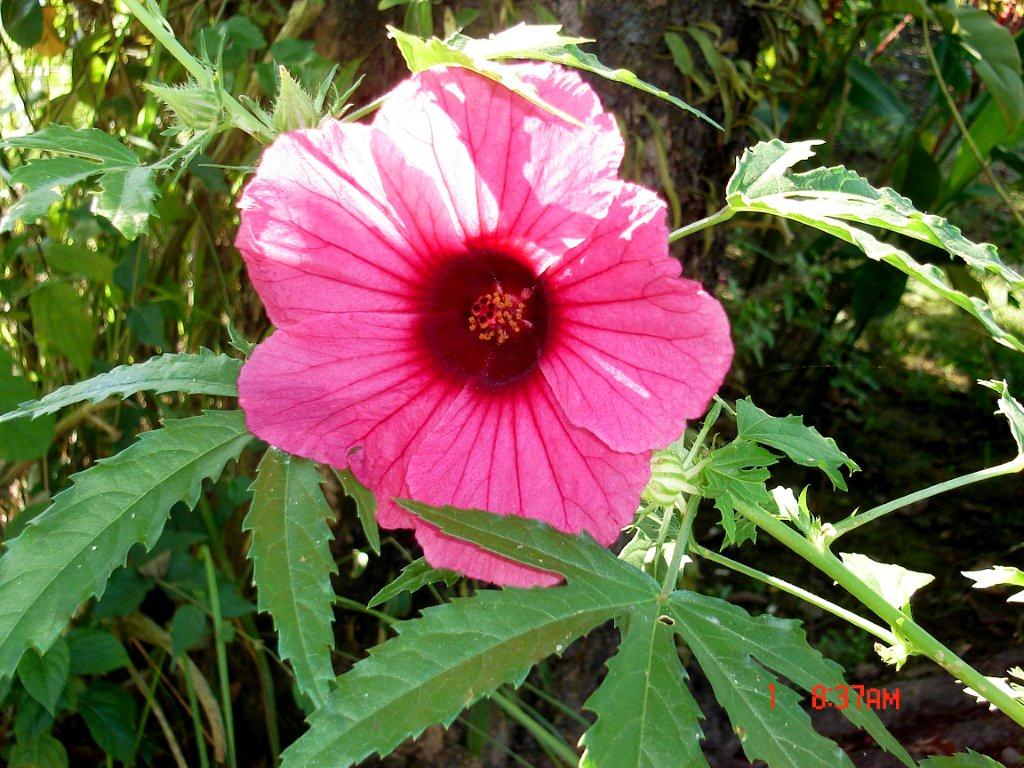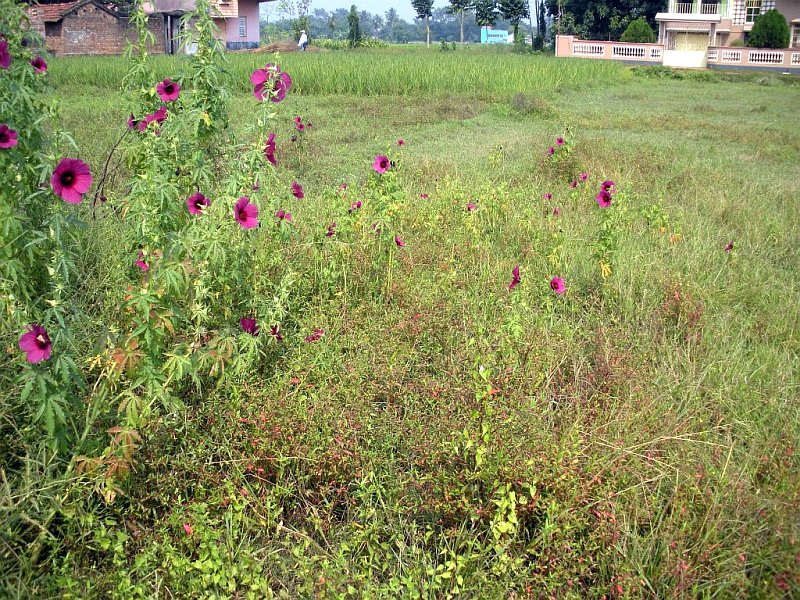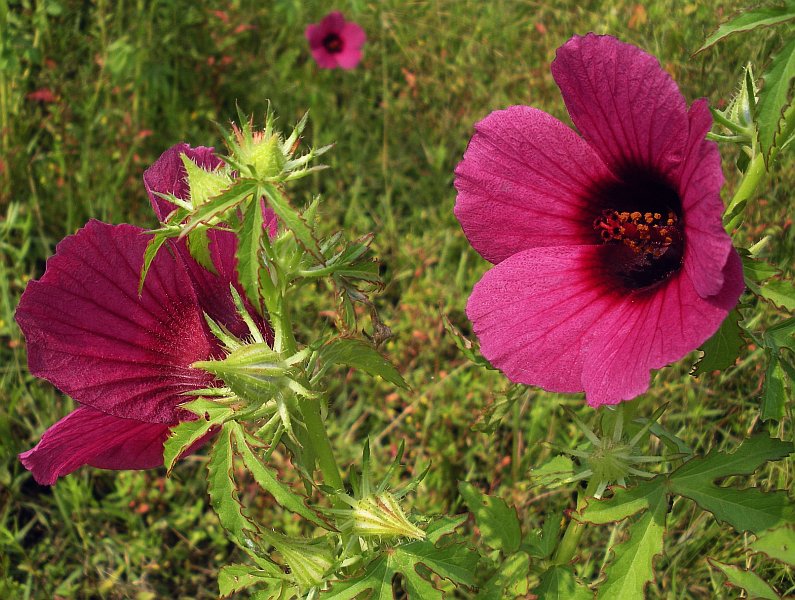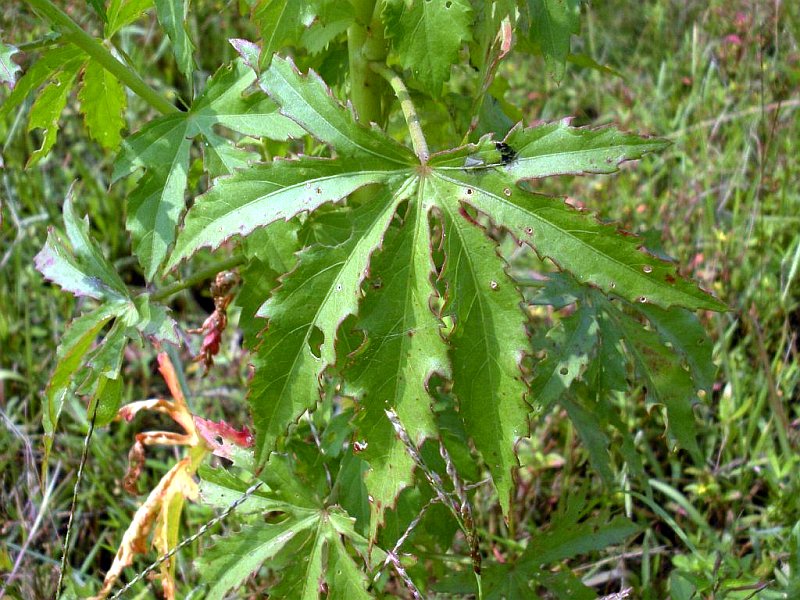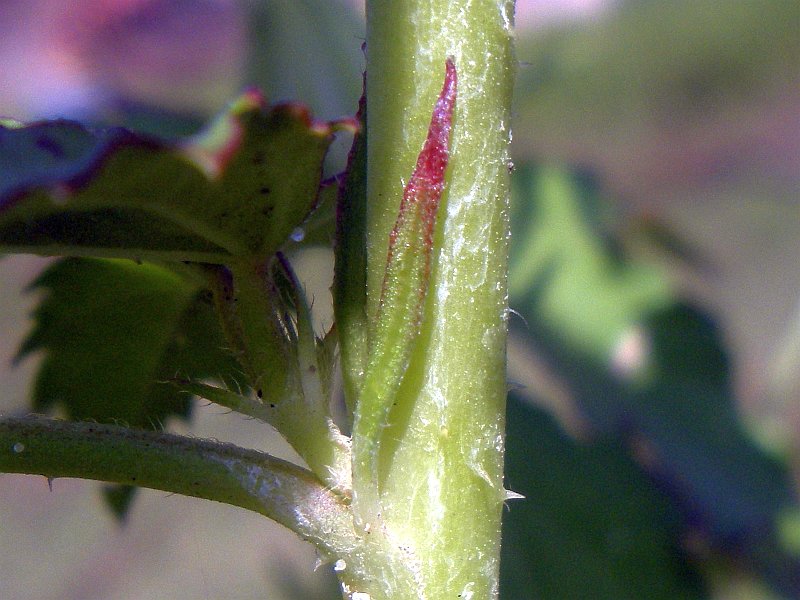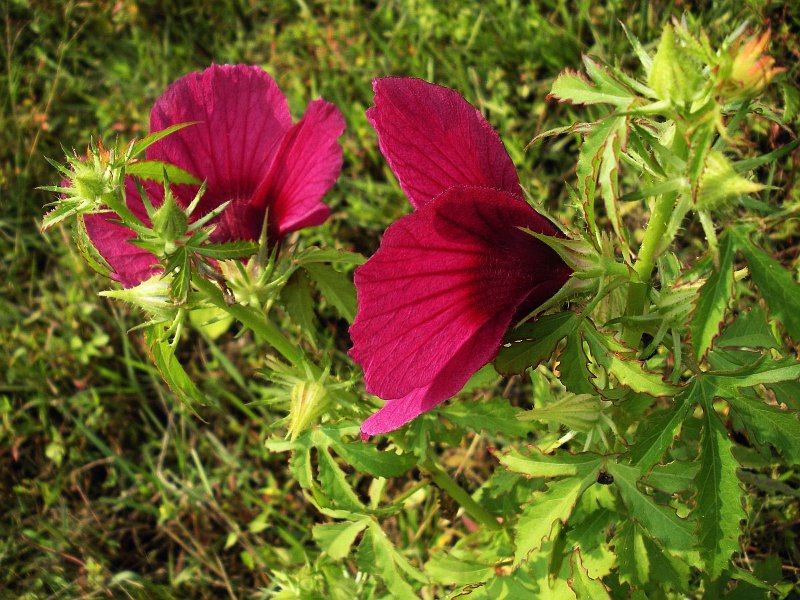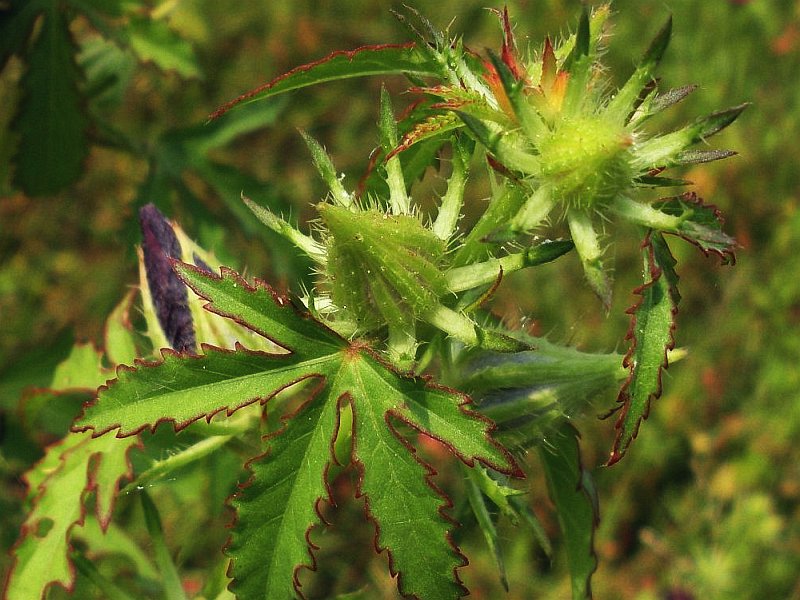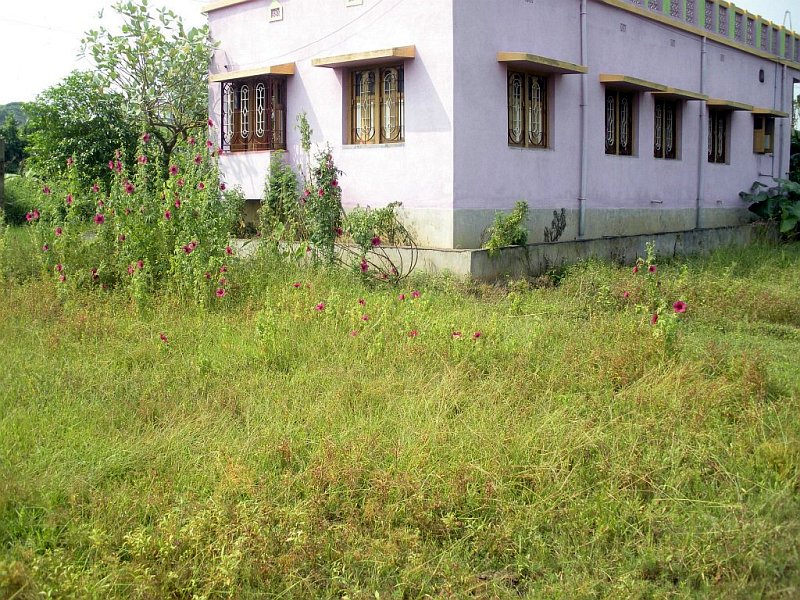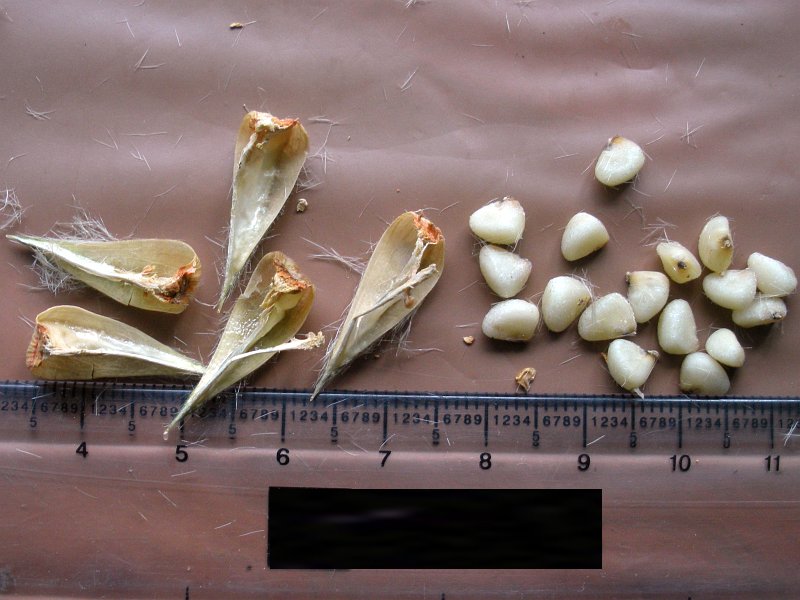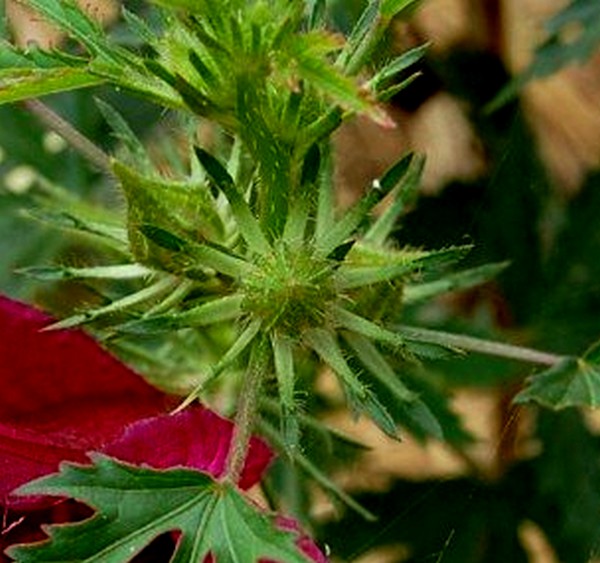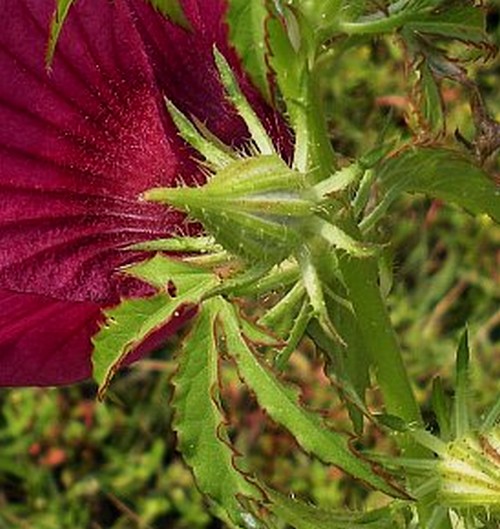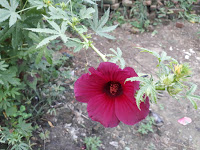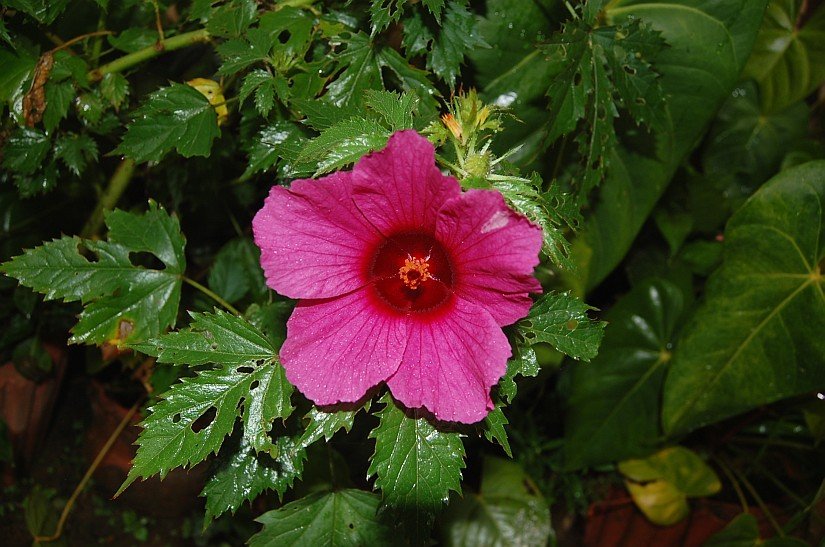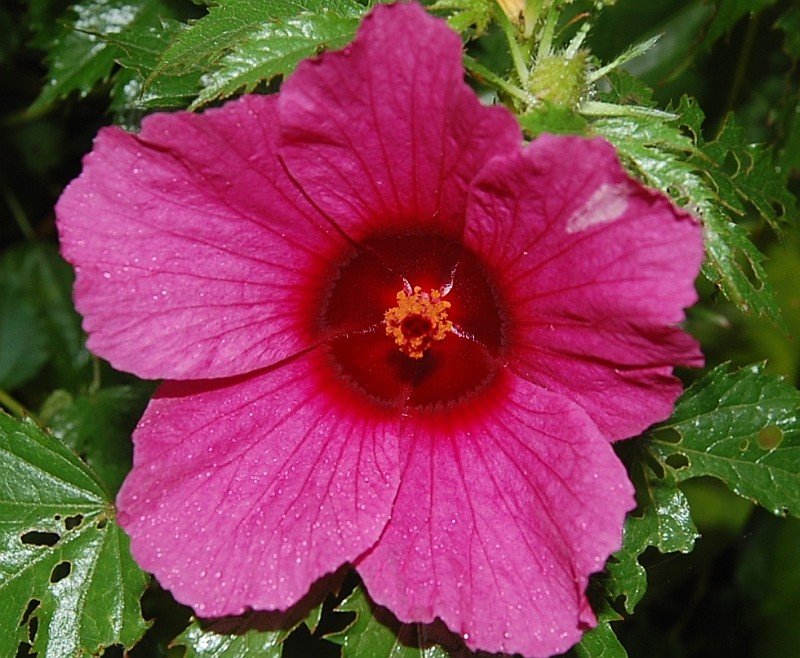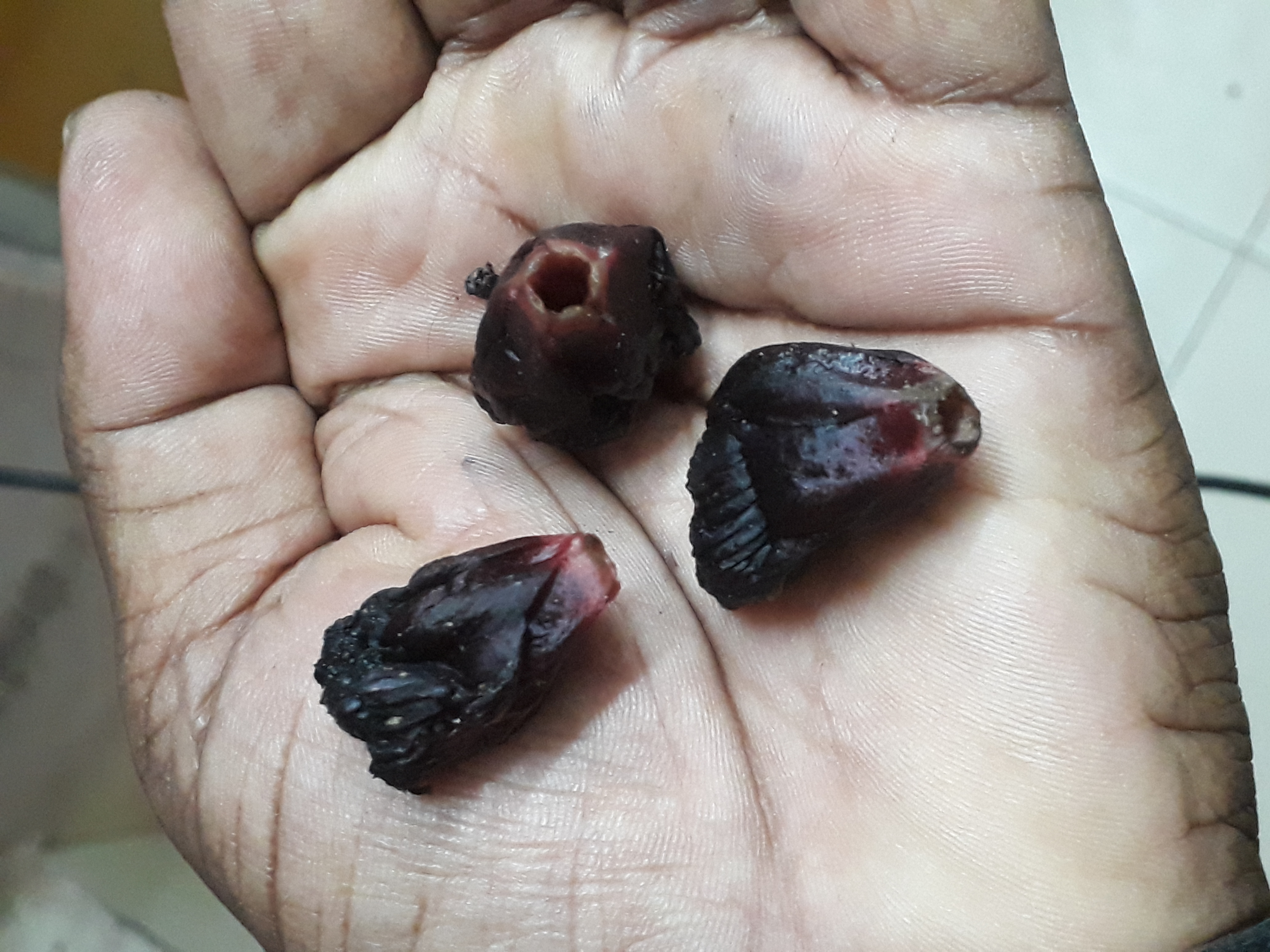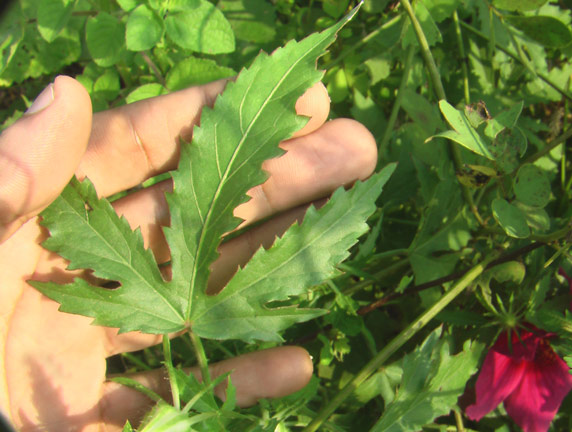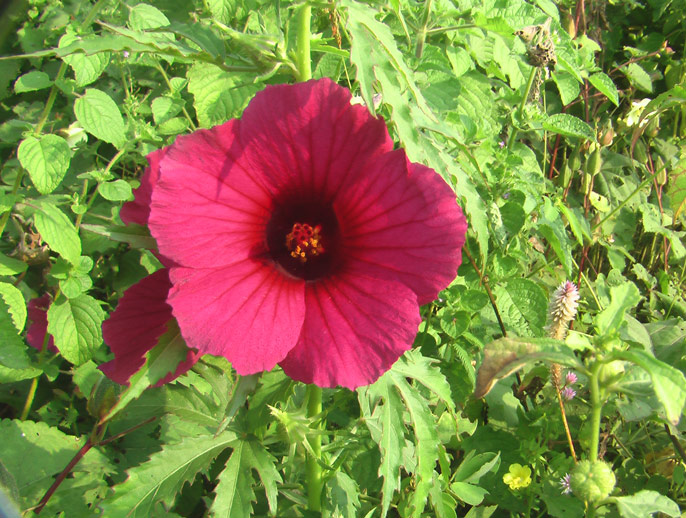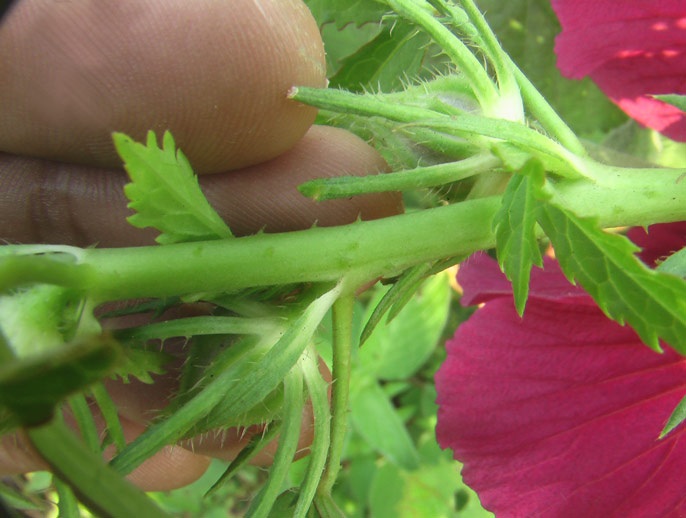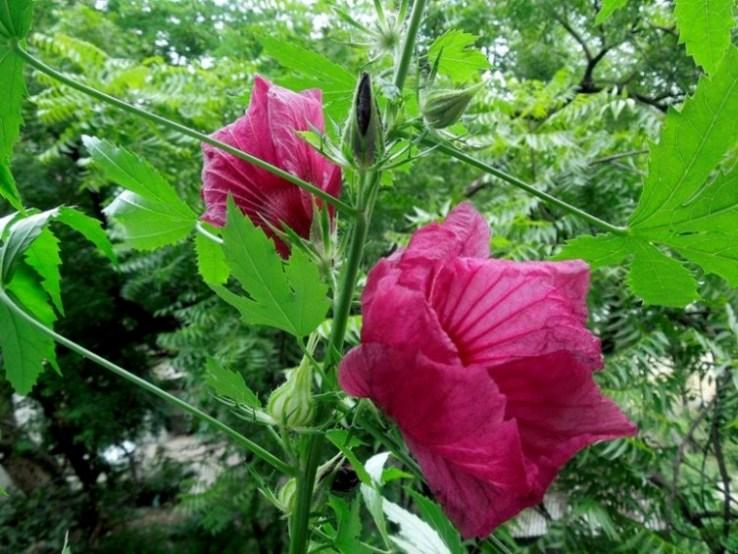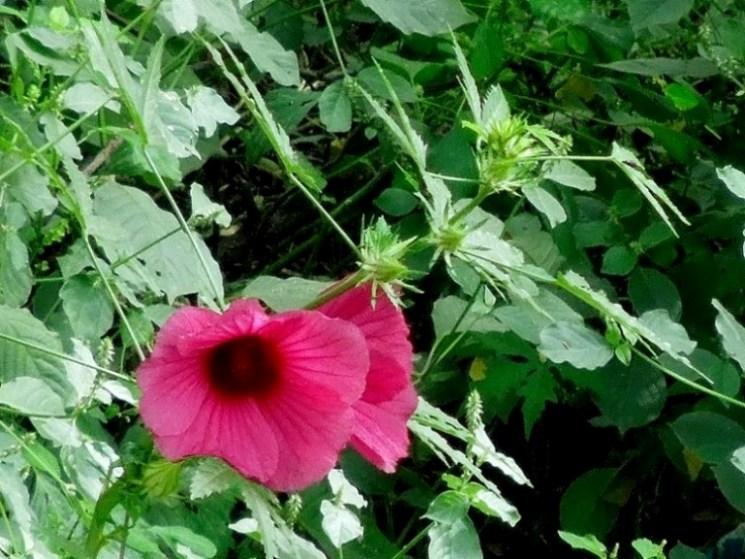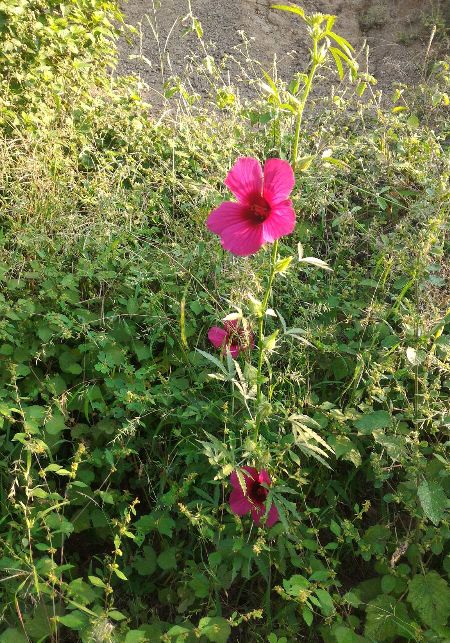|
Hibiscus radiatus Cav., Diss. 3: 150 1787. (Syn: Canhamo braziliensis Perini; Hibiscus cannabinus var. unidens Hochr.; Hibiscus heptaphyllus Dalzell & A.Gibson (unresolved); Hibiscus lindleyi Wall.);
.
Hibiscus furcatus Wall. is the synonym of H. surattensis L., a name used in FBI and still holding true (fork has one spoon shaped appendage and one small erect linear branch; stipules large leafy ear-shaped; leaves 3-5-fid)
Hibiscus furcatus Roxb. described in FBI and now correctly known as H. hispidissimus Griff. (both forks linear; stipules lanceolate-oblong; leaves entire or 3-lobed)
Hibiscus furcatus Willd., a synonym of Hibiscus rostellatus Guill. & Perr. an African plant not found in India .
Other expected species in India, cultivated or naturalised from this group (forked epicalyx segments) include.
Hibiscus radiatus Willd. epicalyx 8-10, with linear fork segments, stipules linear; leaves deeply 3-5 lobed. Hibiscus acetosella: epicalyx 9-10, apically forked, leaves irregularly 3-5 lobed. Hibiscus cannabinus looks similar to above two species but is distinct in deeply 3-7-parted leaves and importantly with epicalyx segments not being forked. . Gutter beauty -Flower for ID – 21Jun11AR01: Date/Time-31 Aug 2009
Location- Place, Altitude, GPS- Hampapura, Mysore
Habitat- Garden/ Urban/ Wild/ Type-, Wild, Grows near cowdung manure pit
P
lant Habit- Tree/ Shrub/ Climber/ Herb-Shrub
Height/Length-approx – 4 feet
Leaves Type/ Shape/ Size- Shape – 5 lobed, digitate, 9cms, margin – toothed Inflorescence Type/ Size-
Flowers Size/ Colour/ Calyx/ Bracts-12cms, purple,
Fruits Type/ Shape/ Size Seeds- No fruits
Other Information like Fragrance, Pollinator, Uses etc.- Grows near cowdung manure pit beautiful flower. I had the same plant with me. It is a type of hibiscus and propagated from seeds and cuttings. its Hibiscus cannabinus Thank you for the the ID help.-Hibiscus cannabinus,
blooms – white, yellow or purple, at times center is dark purple.
elinks-
Hibiscus cannabinus Doesn’t it look like Hibiscus radiatus, the red hibiscus?? Cannabis plant ? The two species really very close, the main difference being that epicalyx sebments are forked in H. radiatus, not so in H. cannabinus
See the epicalyx is important. H. radiatus as per … in the thread
Any guess for following plant:
Location: Varandha ghat, Raigad, Maharashtra
Date of collection: 30.10.12 Habit: Shrub upto 10 feet high. Less branched,
Leaves: Pentafoliate
Flower: Dark purple, 6cm longh, axillary, solitary
Fruit: A schizocarp, 3cm long I hope Hibiscus radiatus Hibiscus radiatus : For Validation : Flower Show,Mumbai : 170214 : AK-8: Attachments (3). 3 posts by 2 authors. The id seems to be right… The closest confusion can be H. cannabinus, …but this looks to be H. radiatus as you have identified..
Isn’t it Hibiscus cannabinus ? I agree with … Hibiscus cannabinus Hibiscus radiatus Malvaceae Fortnight: Hibiscus sabdariffa from Coimbatore -BRSJULY07/07 : 3 posts by 2 authors. Attachments (4) I think Hibiscus radiatus, please note small toothed appendage at the base of narrowly spoon shaped epicalyx appendage in third photograph. It has been discussed many times.
Malvaceae Fortnight- Post 29:: Hibiscus for id from Patiala (Punjab): NS August 14/14 : 3 posts by 2 authors. Attachments (6) Hibiscus radiates 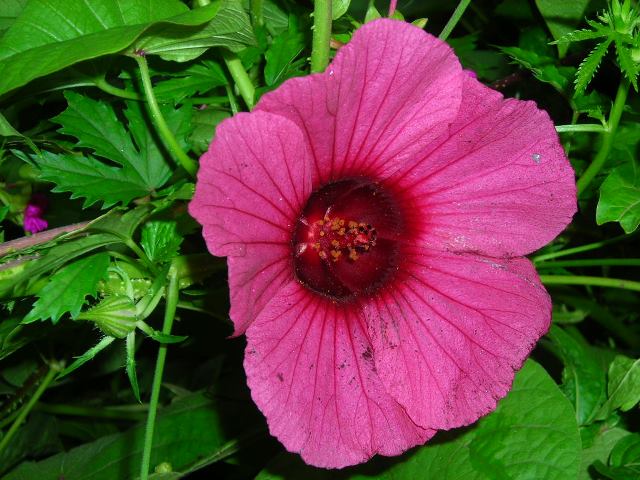  Malvaceae Fortnight:: Hibiscus Sp?? NSJ-17 : 4 posts by 3 authors. Attachments (2) Hibiscus sp for ID. Photo taken at Satara Hibiscus species in eFloraofindia (with details/ keys from published papers/ regional floras/ FRLHT/ FOI/ Biotik/ efloras/ books etc., where ever available on net) Hibiscus radiatus, my upload of the same identified by … Thanks … for the ID  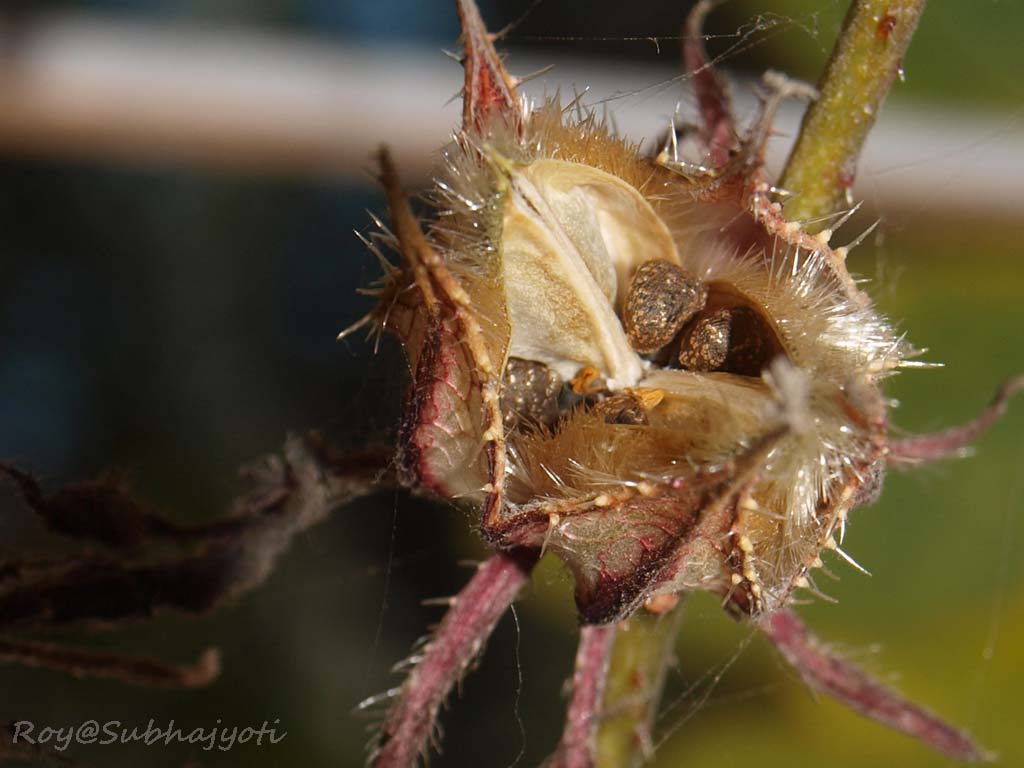 ID please 05072012 SR-2: Date-07.01.2011 Place- Cooch Behar,West Bengal Habitat- Ornamental garden plant, stem is with prickles. Seeds are covered with hairs and thin prickles, get burst during germination. This seems to be a Malvaceae member. Though much info is not available, yet please search for Hibiscus radiatus as in –
One more link – http://davesgarden.com/guides/pf/go/59791/
yet another – http://davesgarden.com/guides/pf/showimage/29466/ The following posts need your attention, please…..
efi thread one, two, three, four, five, six, seven, eight, nine, ten, eleven, twelve, thirteen …… and also this one Malvaceae Week:: Unidentified Sp (RD_07): I think this should be Hibiscus radiatus, please note Cannabis like leaves and forked epicalyx lobes, with both fork segments linear. I think I had written earlier also, in Hibiscus acetosella, out of the two branches of each fork of epicalyx segment, one is large and spoon-shaped, another linear. Not this case. 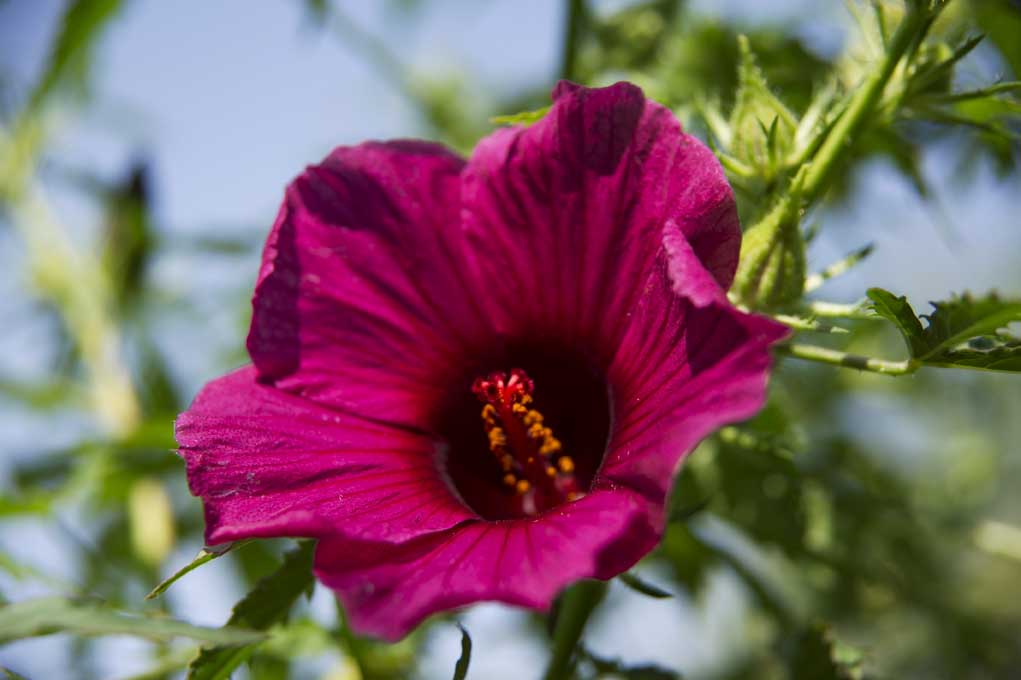 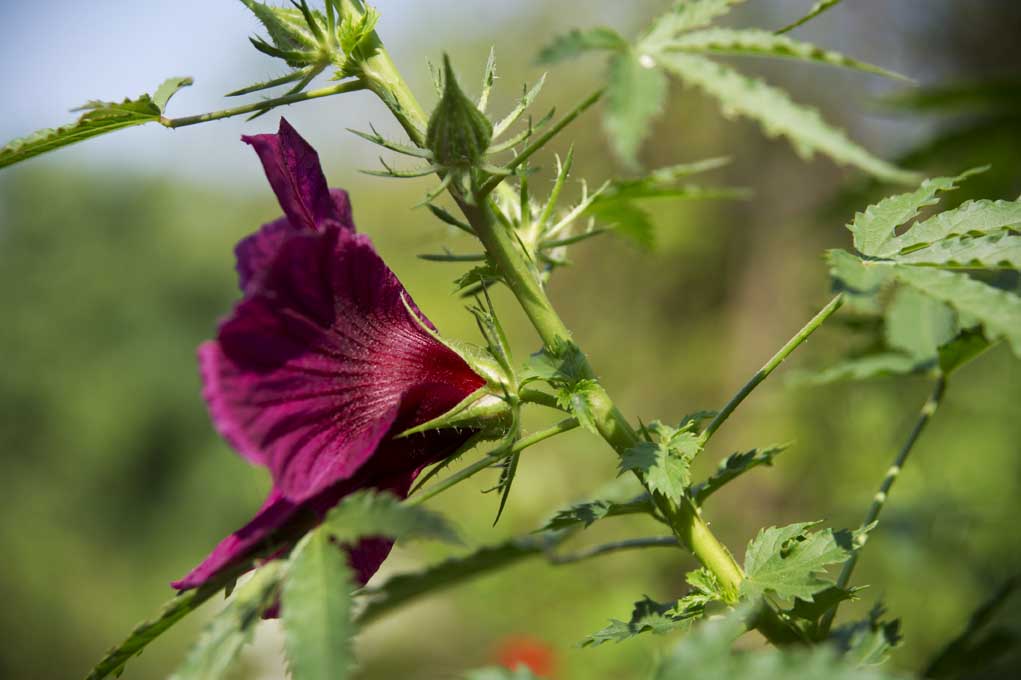 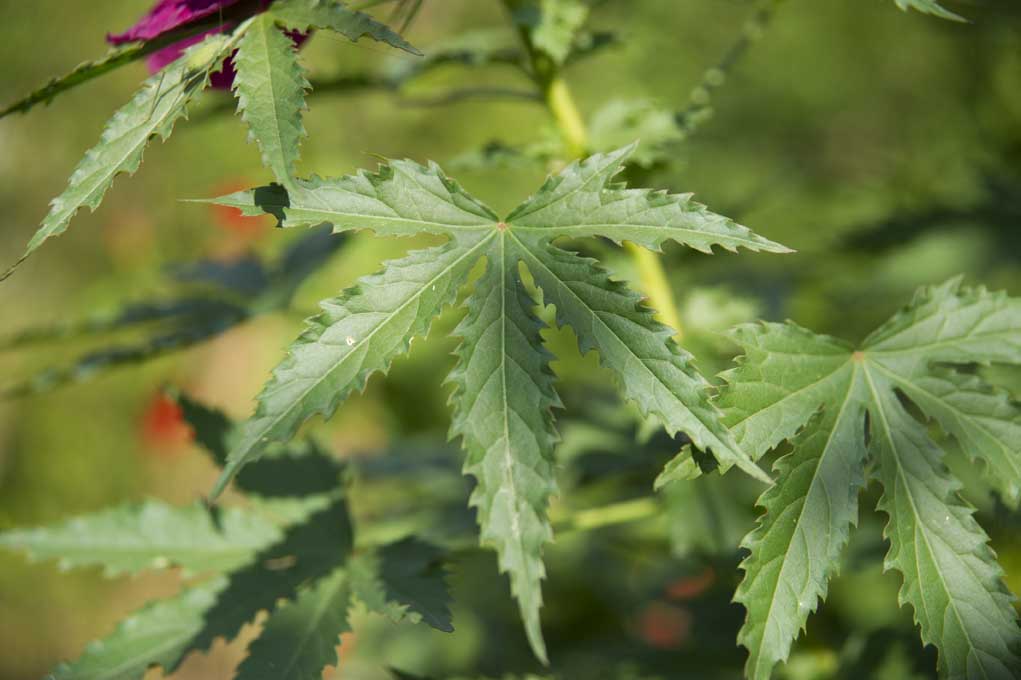 Plant for ID from our garden and Pachmarhi: I brought few seeds of this plant from Pachmarhi where it was growing in wild like a 8 feet tall bush. I put some seed in the garden and now this bush is flowering.
Flower characteristic are more like an hibiscus. about 4-5 inch wide. So the size of leaves.
Pl help in ID may be junglii bhindi? are the fruits red? or the calyx of the fruit red? Could be Hibiscus cannabinus, commonly known as Deccan Hemp. I had posted the same earlier and it was identified by … and … as Hibiscus furcellatus, common names Sleepy Hibiscus, Hawaiian Pink Hibiscus, Salad Hibiscus or Linden-leaf Rose Mallow. It may be a cultivar of Hibiscus radiatus (?). Hibiscus furcellatus looks different in this link : Hibiscus furcellatus in toptropicals.com looks the same. Kindly check.
I am unable to give the link. Similar ones were posted by me earlier and identified as Hibiscus furcellatus.
Today I saw a post with similar flowers identified by you as Hibiscus sabdariffa.
Kindly validate so that I can correct my earlier post too. It can’t be H. cannabinus as bifurcate epicalyx tip is very clear, also the outer branch is almost linear suggesting H. radiatus. To be doubly sure look for nectary on lower side of the leaf near base. It should be missing. They must also be missing on the calyx lobes (nectary is present on each calyx lobe and leaf beneath and epicalyx appendage is missing in H. cannabinus).
Found growing wild in a unused plot of land.
The flower seems similar to the one posted by me earlier from Alleppy, Kerala.
Only difference seen by me is in the leaves.
Here, leaves are trifoliate. Hope Hibiscus radiatus. Please check for absence og gland on underside of leaf near base and on each calyx lobe. Many many thanks for the id.
I will keep in mind and take more pictures when I visit Nasik next time. ornamental Malvaceae from Hooghly 27/10/12 sk3: Species : Hibiscus cannabinus L. ?
H & H : ornamental herb, about 6 feet and smaller
Date : 26/10/12, 10.30 a.m.
Place : Hooghly Nice pictures… They look like Hibiscus radiatus to me. Yes, this plant looks like the ones in the link you have provided, with 5 lobed leaves.
There is a discussion in the Dave’s Garden – http://davesgarden.com/guides/pf/go/59791/#b that claims H. radiatus is an allotetraploid of H. cannabinus and perhaps H. surratensis.
Thank you very much for the probable ID. Yes …, I have also gone through the discussion and was about to post the differences compiled that I read your notification. In fact the discussion should involve H. cannabinus, H. sabdarifolia (since Flora of Pakistan treats them synonyms), H. trionum (such reputed website as Wikimedia commons shows picture of this as H. cannabinus ………http://commons.wikimedia.Hibiscus_cannabinus.JPG), H. radiatus (most often confused with H. cannabinus) and H. surattensis (as supposed parent of H. radiatus, and would have some characters in common). I will try to explore and report. In the mean time here are the differences between the two: Hibiscus cannabinus H. radiatus 1. Diploid species 1. Allotetraploid involving also H. surratensis 2. Leaves and calyx lobes glandular 2. Leaves and calyx lobes not glandular 3. Epicalyx attached to Calyx 3. Epicalyx free from Calyx 4. Elongate nectary on base of midrib 4. Nectary absent Beneath, and midvein of calyx lobes 5. Calyx white tomentellose 5. Calyx not white tomentose 6. Epicalyx segments without 6. Each epicalyx segment with a tooth-like appendage just below tip on inner side 7. Flowers 10-15 cm across 7. Flowers 7-9 cm across
This species H. radiatus has already figured in many long discussions on our group. It can be searched from the forum
Thank you very much Sir for taking all the pain and explaining differences. It is H. radiatus Cav. Attaching an image showing inner tooth on epicalyx. Another query i do have now, is it H. radiatus Cav. or is it H. radiatus Wild. ex Roxburgh or is it H. radiatus Sieber ex Steud ? i found all these names in IPNI.
I checked earlier group discussions –
My plant has both 5 lobed and 7 lobed leaves.
And, finally, i myself did once, without knowing anything at all, only by comparing flowers!!! – efi thread 7
Which H. radiatus this species is? Yes … In fact there are two other species with this appendage on inner side of calyx: H. surratensis: The supposed one of the parents of S. radiated where the appendage is much longer so that tip looks forked and outer branch is ovate, flowers yellow with dark red centre, stem strongly prickly with curved prickles, large auriculate stipules and calyx turning red in fruit.
H. hispiidissimus: Also the two branches of epicalyx equally long, outer oblong-ovate, flowers yellow with dark center, stem prickles straight with prominent basal tubercle, stipules lanceolate.
http://www.flickr.com/photos/dinesh_valke/4226841707/
The appendages are much smaller in H. radiatus and corolla red. If we go to Key no.5 of Hibiscus in FoC we see –
Stems with reflexed or retrorsely curved prickles; epicalyx lobes with
foliaceous appendage at or above middle ….. …………….. ……………………. ……. 6
Stems usually without prickles; epicalyx lobes with or without appendages … 8
H. radiatus, H. surattensis & H. hispidissimus are included in the group 6 above and further divided into sub group 7. So, Hibiscus radiatus should have foliaceous appendage on epicalyx.
FoC further informs H. radiatus (i hope H. radiatus Cavanilles) has “stipules filiform“. I am attaching 3 more pics that show neither foliaceous appendage nor filiform stipules (pic no. 103).
H. trionum, H. sabdariffa & H. cannabinus are included in the group 8 above and further divided into sub-group 9. It is interesting to note, as per FoC, while H. sabdariffa has spiny appendix on epicalyx H. cannabinus does not.
So, please take a relook at this species before concluding the thread at – efi thread.
My last question – is H. radiatus Cav. a synonym of H. radiatus Willd.? If it is so H. radiatus shuld have leaves only upto 5 lobes as per the discussion in efi thread. Let me explain it this way. There is an appendage on the inner side of epicalyx just below the tip which may be a small tooth or long spicule as long as the outer apical part which as you see slightly more darker green, narrow spoon shaped (or linear-lanceolate). This is what Flora of china refers to foliaceous appendage which may be linear (H. radiatus), ovate-oblong or ovate as I mentioned earlier.
As far as leaves are concerned have alook at this illustration in Flora of China
there are 6 clear lobes. If understand it correctly the uppermost leaves are 3-lobed or 5-lobed (your images 3 and 4), the lower leaves may have 6- or 7-lobed leaves.
Have said that, who knows my interpretation may be wrong. I have written a detailed note in Fresh Relook of “Gutter Beauty” uploaded earlier by … and which I think is same as your plant. I received the mail relating to “Gutter Beauty”, so, i decided to take a re-look at my post. I searched and found H. radiatus (Cav. or Willd., don’t know which) can be yellow too,
Found some pics of epicalyx & stipules of H. radiatus –
Found species info, not description –
As I understand The species was named by Willd. and reported in most earlier books as H. radiatus Willd., 1803. The description appeared in book by Roxburgh, 1832 in greater detail and species came to be known as Willd. ex Roxb., 1832. More recently it has been known that earliest description appeared in publication by Cavanilles (abbr. Cav.), 1789. H. lindleyi Wall., 1830 is also the name for the same species. Applying the principle of priority, H. radiatus Cav. is taken as correct name for the species.
And yes, as it appears in FBI flowers may be yellow with dark centre or totally purple.
Perhaps this statement in book should be important in better understanding (see attachment). i have taken so much of your time i cannot express my gratitude in writing. I can only attach fresh pics, this time with some statistics, measured by scale. But, i could not dig more because of its minute, very sharp prickle. so many seeds? I took risk of annoying the owner by visiting the place twice within a couple of days. I could not find any fully mature seed-pods there, i think it explodes as soon as it gains maturity, spreading all its seeds.
Moreover, people in general might not be aware of spiny difference between H. cannabinus & H. radiatus. I am not going to invite any legal notice. legal notice? Notice for trespassing with dubious intention and intrusion of privacy. Neither i know the owner nor he/she knows me. This plant seems to be an annual, attaching photos recorded today. Date/Time : 18th of October, 2008/ 12.30 pm
Location Place : Backwaters of Alleppy,Kerala … Altitude : … GPS : Habitat : Garden … Type : cultivated Plant Habit : Herb … Height : small plant … Length : Leaves Type : … Shape : … Size : about 2-3 inches Inflorescence Type : … Size : Flowers Size : about 2 inches … Colour : Purple Other Info : Fragrance : did not check
Is it Deccan Hemp? it is Hibiscus furcellatus This Plant is Hibiscus furcellatus commonly known as Hawaiian pink hibiscus or Sleepy hibiscus. I think H. radiatus only In H. furcellatus the flowers are usually light pink, leaves are cordate and not lobed like we have in H. radiatus or H. cannabinus, also the appendage on tip of epicalyx is different.
Malvaceae Week: Gutter beauty -Flower for ID – 21Jun11AR01……..A relook: While going critically through the plant uploaded by …, and seeing some older mails I came across this thread with plant uploaded by … It seems this plant is same as one uploaded by … and identified as Hibiscus radiatus,
In thread of of Gutter Beaty uploaded although suggested of H. acetosella by … (which we ignored as we could not see the forked tip of epicalyx) most members concluded H. cannabinus.
There are atleast four species in which epicalyx has an appendage on the inner side
In both H. surratensis and H. hispidissimus, besides usually yellow flower with dark center the appendage is almost as long as epicalyx tip so that epicalyx tip appears forked
H. surratensis: tip looks forked and outer branch is ovate, stem strongly prickly with curved prickles, large auriculate stipules and calyx turning red in fruit.
H. hispiidissimus: tip looks forked, outer branch oblong-ovate, stem prickles straight with prominent basal tubercle, stipules lanceolate.
In other two species H. acetosella and H. radiatus the appendage is very small and looks like a small tooth below the tip on the inner side.
H. acetosella: Stem and leaves are usually red in colour and tip of epicalyx slightly expanded
H. radiatus: leaves are green, segments narrow and epicalyx tip much narrower, linear. The length of appendage may vary from small tooth to almost as long as the slightly broader tip as can be seen in following photograph
I have cropped and enlarged the photographs from … and … to show that they are the same and belong to H. radiatus.
I have the feeling that most red flowered photographs of H. cannabinus may actually belong to H. radiatus, as majority of these photographs on even reputed websites of C. cannabinus have toothed appendage.
The members have access to H. cannabinus can help in resolving this confusion
1. locate yellow flowered form of H. cannabinus (as H. radiatus never has yellow flowers), confirm presence of oblong nectary on the under of the leaf near base along the midrib, and similar on calyx lobes, and make sure the toothed appendage of epicalyx (small tooth or long) below the tip inside is missing; also leaves and calyx lobes would have glandular hairs.
2. locate red flowered form of H. cannabinus and look for above features. If glandular hairs are missing, oblong nectary missing from leaf and calyx lobes, epicalyx appendage is present, it should be H. radiatus.
Please do point out if I am wrong somewhere.
Please be warned that there is lot of confusion on the net, with such reputed websites as Wikimedia commons having photograph of H. trionum labelled as H. cannabinus, and many other sites labelling red flowered H. radiatus as H. cannabinus
http://commons.wikimedia.Hibiscus_cannabinus_(Eibisch).JPG
This exercise will perhaps help us resolve the issue. Hibiscus For ID : Flower Show,Mumbai : 28MAY17 : AK-19 : 4 posts by 3 authors. Attachments (3)
Came across some pictures from Flower Show in Jijamata Udyan, Mumbai. Pictures taken in mid Feb, 2014.
Hibiscus radiatus?
Hibiscus cannabinus…!! Thanks a lot … Similar ones posted earlier have been identified as Hibiscus radiatus. So I was confused. I think it should be Hibiscus radiatus as per images, details and keys herein.
Anyways, I’ve found out that it’s Hibiscus cannabinus. I think it should be Hibiscus radiatus as per images, details and keys herein. Yes sir ! Hibiscus ?
Yes Hibiscus canabinus
ID-090309NSJ – indiantreepix | Google Groups : 1 image. I think it should be Hibiscus radiatus as per images, details and keys herein. Definitely.
Planted in a home garden and cared .. unlike the gutter beauty posted earlier.
https://groups.google.com/group/indiantreepix/10…
Season: Monsoon Habitat: Garden, Malenadu, Western ghats Murnaadu, Coorg Abundance :1 plant. 03 Sep 2009 It would be useful if you could upload closeup of flower or fruit showing epicalyx in detail. I think it should be Hibiscus radiatus as per images, details and keys herein. Yes sir ! Flower for Id – ID04102019SH3 .Is this Hibiscus acetosella ? : 11 posts by 5 authors. Attachments (2)- around 500 kb each.
Flower for id pl. Is this Hibiscus acetosella ? or Hibiscus radiatus ? H.cannabinus ? Efi page available at
Also check with keys at leaves are three parted, the ones I can make out and green…
features that favor Hibiscus cannabinus
Bifid epicalyx shggests H. radiatus .. yes, Its bifurcated but
judging from our own page I quote….
Other expected species in India, cultivated or naturalised from this group (forked epicalyx segments) include.
Hibiscus radiatus Willd. epicalyx 8-10, with linear fork segments, stipules linear; leaves deeply 3-5 lobed. Hibiscus acetosella: epicalyx 9-10, apically forked, leaves irregularly 3-5 lobed. Hibiscus cannabinus looks similar to above two species but is distinct in deeply 3-7-parted leaves and importantly with epicalyx segments not being forked. end quote we are back to radiata versus acetosella
only real difference seems to be linear stipules…. yellow highlight I added …
I need help then More close to Hibiscus acetosella ?? Colour of plant and foliage. yes green leaves must be factored in the differential Thanks … for the clues. The flowers were again in the wild and not cultivated. Fwd: Fallen flowers of Hibiscus rsdiatus : 1 post by 1 author. Attachments (1)- 2 mb.
Sir, sorry to send this left photo of fallen flowers, I think unpollinated. . Wild flower ID request – RK31 – 26-Oct-2012: This is Hibiscus sabdariffa, an exotic grown for fibers. Tambdi Ambadi in marathi. This is Hibiscus radiatus Cav. as per images and keys herein. ID Request 061013SG : Attachments (2). 2 posts by 2 authors. Hibiscus sabdariffa or Lal Ambadi, usually seen as an escape. It is be Hibiscus acetosella Welw. ex Hiern as per images and keys herein. Sorry, I want to say: Fwd: pls help me in identifying these plants- Mew 111015- 1 : 5 posts by 3 authors. Attachments (2) The first one is well known Hibiscus cannabis (the leaves used to prepare acidic chutny in the southern states) Hibiscus cannabinus. notice the spelling Hibiscus radiatus, perhaps. H. sabdariffa. I find both plants to be same. This is Hibiscus radiatus Cav. as per images and keys herein. Flower for Id- ID23102015SH1 : 6 posts by 3 authors. Attachments (1)Picture of flower for Id pl. wild bhindi. hibiscus sabdariffa i think. good source of vit c if its the roselle. lets wait for experts But …, in roselle (Wild bhindi),the flowers are yellow coloured ? roselle …i have never seen yellow flowered roselle
wild bhindi to me is a loosely used term that describes roselle and other non-cultivated bhindi … not very scientific… but then i like it as a quick recognition tool and then go forward…
in this case we went to h. sabdariffa s my id for it..
wild bhindi from north india seem to have yellow flowers I think … had shown some here in the past you may want to go to this site (our website and search) efi thread Appear like Hibiscus sabdariffa as per images at this link. Although details are not clear, this is Hibiscus radiatus Cav. as per images and keys herein.
. I’d of Hibiscus: 2 high res. images. Hibiscus radiatus Cav. I also agree as per images at Hibiscus radiatus
. References:
|
Hibiscus radiatus
Updated on December 24, 2024


